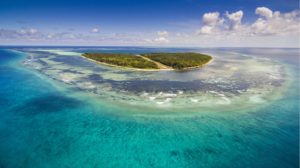
An ariel of the island Alphonse and its surrounding atoll
As I settle back into the routine of work and sitting at my desk on the computer I discover that jet lag is a very real thing. I’ve been waking up bright-eyed and bushy tailed at 3am. It’s useless trying to go back to sleep so I get up and try to be productive. Then by early evening I’m struggling to stay conscious. I yearn to be outside and my body is craving movement, sunlight and salt air. Trust me, I’m asking no sympathy. I recognize I’m very lucky to have such problems.
My recent trip to Alphonse in the Seychelle Islands was simply magnificent. I flew about 3 hours from Denver, Colorado to Atlanta, Georgia. Then another 9 hour direct flight to Paris, France. After Paris there was another 10 hour flight to Mahe’ in the Seychelles where I spent a night in Victoria, the capital. In the early morning I took off again on a small jet to fly south one more time on an hour flight to reach Alphonse Island. Total flight time was about 23 hours.
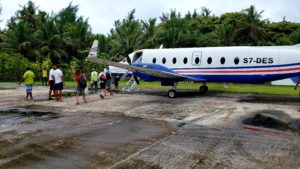
Our jet from Mahe’. The runway was very, very short
When we arrived we were welcomed by staff, given a rundown of amenities, dining times, activity options and shown to our beachfront bungalow. As soon as my luggage and gear was delivered, I set up a rod and started casting from the beach. The water was clear and stingrays, bonefish and other ocean species could be seen just feet from the shore. I wanted to get some practice with my Winston 12wt Salt Air. That rod is a beast compared to the tenkara rods I typically cast – even compared to the Zen Kyojin which is the most powerful tenkara rod out there.

Giant Tortoises lonely live on Galapagos and the Seychelles Islands. They liked the bike path.
Just a short bike ride away was the fishing center where I met all the guides, went over my gear and flies and discussed tenkara. I was relieved that everyone was open to the idea abet a bit skeptical. I assured them I wasn’t going to be casting to GTs but had already landed a few bluefin in the Maldives. They were impressed and curious about the rods and several wanted to give it a try. That, in my opinion, is the sign of excellent guides. They’re not heroes, super cocky or too cool to try something different. They know their water, they know the fish and they work to get you into them, no matter what your fishing style.
The following week proved to be as incredible as I had imagined it would be. Don’t get me wrong, we worked for fish and the guides put in a lot of time on the pole. The weather fluctuated between blazing hot and sunny, to overcast, windy and heavy squalls. Whatever was delivered, we worked through it and continued to hunt and fish. Most days we looked for stingrays and sharks on the horizon. GTs like to tail them and cruise along side these two flats dwellers. Other days we waded 5 miles in the breaking surf watching for fish in the underside of the crashing waves. Both bluefin and GT could be found here and on the backsides of shark and rays preying on bait fish coming in and out with the tides. Often you’d cast and rip your strips in front of a GT, only to have a bluefin pound it. Going head-to-head for the same fly, a bluefin will almost always come out the winner. I was happy either way.
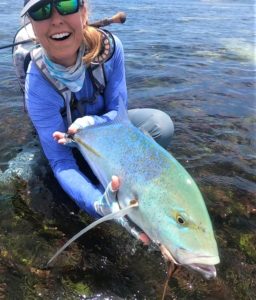
A bluefin on my Hatch Reel and Winston Rod setup
Besides bluefin and “Geets” as the guides called them, we also were in bonefish lala land. My favorite fishing was one afternoon on the flats. The bottom is soft fine sand. No shells, rocks, coral or other buggers. I decided to go native like several of the South African guides and walk it barefoot. This was the very definition of glorious. Sun shining down, wet wading barefoot, casting to bluefin and bonefish coming off the shelf and onto the edge of the flat. I used both my Kyojin and my Winston 8wt with my Hatch Finatic Reel, switching off every hour or so. Strolling the edge, back casting the tenkara rod and double hauling to pairs of “proper” (South African slag for BIG) bones just coming into eye sight. This was simply, a perfect day.
You wouldn’t normally use tenkara and Seychelle in the same sentence. It’s not where people think of when you talk about tenkara destinations, but these days, everywhere is a tenkara destination. Regardless of where I go or what species I’m targeting, my tenkara rods always comes with me. I may be packing my 10 and 12wt rods and by massive saltwater Hatch reels, but I’ll never not also bring a fixed line setup too. On this trip I was limited to 33lb of luggage and gear combined. That included my toiletries, my GoPro stuff, my regular rods and reels, my leaders and fly boxes, my clothing, shoes, sunblock and Simms Wading Sneakers, and yes, my tenkara rods and lines. I was underweight. I still had plenty of room for several tenkara setups.
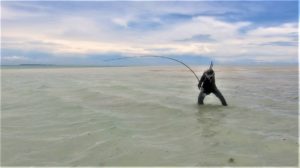
Fighting to stay in the power curve as the fish attempts to run
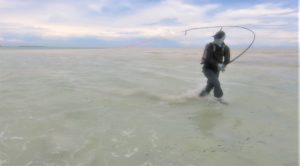
IN control and bringing the fish back around
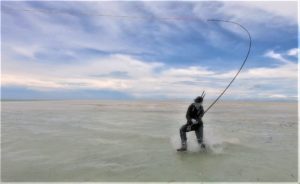
Keeping up with another run from the fish
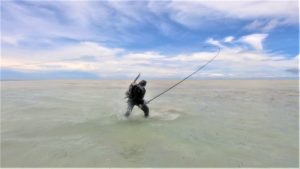
Turning the fish around
Towards the end of the fishing day and the end of the week I really appreciated transitioning out of my 12wt rod and reel and into an ultralight 3ounce tenkara rod. It was nice being able to cast with either my left or my right hand and give my regular casting arm a break. I didn’t stop fishing, I just changed it up and stayed fresh and accurate all day through. Even better, I had the opportunity to dance with bones – to feel the fight intimately and win the battle fair and square by my own skills and abilities. I can say it a thousand times but until you try it, you just can’t understand it. The feeling is raw, fresh, unencumbered like running naked through the wind or going commando. There’s simply a freedom and primal response to tenkara fly fishing. And while I love to hear my reel rip line, the experience is somehow “dampened” by a reel. Tenkara delivers a FBE – a Full Body Experience that’s just different from the reel.
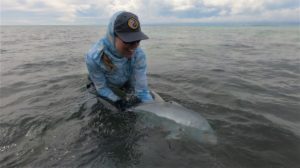
A beautiful Giant Trevally or GT about to be released
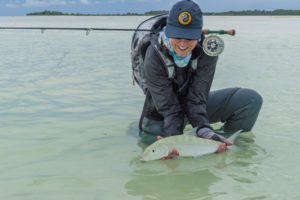
A bonefish on my Winston rod and Hatch reel set up. Variety is the spice of life.
I love my rod and reels and I’ll never stop using them. But I feel the same about my tenkara rods. There will always be room for at least one extra 3 ounce tenkara rod and a few lines in my bag, and I will always seek out the opportunity for that incredible adrenaline surge that comes from a tenkara fight and landing, and the thrill of being reel-less and wild, in the water world.
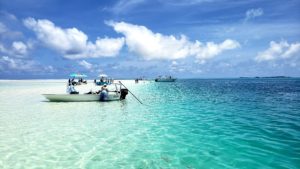
Lunch on a sandbar. A perfect day.
Thank you Alphonse Fishing Company for a most spectacular fly fishing experience. I hope to come back again and try Como. Tight lines and happy fishing – whatever your method!
Karin Miller, Owner/Founder




Hey Karin, that looks like tons of fun! I noticed you were wearing a backpack for gear. Have you found any that you prefer? I’m looking for longer but not bulky pack that will house my Zako rod tube, a light weight glass rod tube, reel, water, and the usual fly fishing gadgets for day trips into mountains. The Patagonia Hybrid pack/vest might do it, but I’m still asking around to see how others doing this.
Steve
Hi Steve. It was a few tons of fun. Wish I was back there now…0 cases of coronavirus and magnificent fishing. That’s paradise in a nutshell. On this trip I tried out the new Simms Dry Creek Z Fishing Backpack. I really wanted something that was truly waterproof and this thing is. It even floats! It has no exterior pockets to hold rods – whether tenkara or traditional fly rods but does have strap mounts where you can add rod cam straps to lash a rod tube to. Since I had the benefit of a boat and a wonderful guide, I generally didn’t have to carry additional rods myself. If it was a dry day, I could have stood them up inside the pack and then snudged the zipper down around them (but it would not longer we waterproof, obviously). I have used a varaiety of different pack from different companies and for the day-to-day typical fishing excursions where you want to carry a snack, another layer, water and possibly another rod, I tend to always go back to my old favorite, Vedavoo. This Made in America pack is compact but still extremely roomy. Best of all it has 2 side pockets with the added security of adjustable straps that are perfect for holding rods. They are deep and are made with a material that stretches so I can pack several rods into one. Beyond the two exterior side pockets, it’s a relatively simply pack. It has a number of cinch cords and places for external accessories, plus it came with an additional mini pack that can be attached to the outside or worn alone for those minimalistic fishing days where you only need a small box of flies and some tippet. The mini pack can also hold my phone and a Lifestraw as well as a few snacks (bigger than expected). I’ve had it for years and it barely shows any wear. I have 2 issues with this bag: 1) it’s not waterproof or water resistant. Although I have to admit, I’ve worn it in the ran and my contents stayed fairly dry…just slightly damp. But I have had more moisture issues when I waded in deep water and soaked the bottom of the bag. 2) this is more of a wish…the mini pack is a fantastic size and while I generally don’t like things on my chest because it obstructs the view of my feet, this pack is streamline enough that it wouldn’t do that IF, there was a way to attach it to the FRONT straps of the backpack. I get annoyed that I have to remove my backpack to access the mini pack. I suppose I could wear it on it’s own strap, but who want another thing hanging around their neck. Scott, the owner has offered to attach clips to my front front straps to allow for this – I’ve just never taken him up on the offer. Maybe this is a good time to call that in? I also had an older Orvis sling pack that had a similar exterior pocket that was perfect for a tenkara tube but gave it to an aspiring new fly angler.
Funny, I also own the Patagonia Hybrid pack/vest and that was another one of my favored pieces of gear. I loved having those pockets upfront and accessible but still have an unobstructed view of my feet. Plus it held my net comfortably and simply was a good size for day trips without being overly huge. Simms does make a smaller Dry Creek Z Fishing Sling. It’s 15l compared to the 35l backpack. I LOVE that it’s waterproof (that’s a big deal for me), and is set up similarly to their backpack version with a big room interior and those exterior mounts that accommodate rod straps. Oddly, I actually snug the shoulder sling strap and wear it as a waist pack. This would mean that the rod tubs would be horizontal and stored on the bottom of the pack. Haven’t tried holding the rod tubs yet but may give it a go.
If waterproofing isn’t important to you and massive storage it’s what you’re looking for, then check out Vedavoo packs for some efficient, streamline, quality options.
Pingback: Tenkara and Fly Fishing Pack Review: Just my opinion | Zen Tenkara
Hi Karin,
I’d love to hear more detail on how you used your tenkara rods on this trip. What was your set up like? I’d enjoy hearing what you learned from your successes and failures. That looks like a very challenging fishery for tenkara!
It was very challenging simply because everything was just so BIG! I didn’t go down there wanting to cast to a 50lb GT. I did hope for an opportunity for a junior GT and definitely bluefin again, which we landed in the Maldives Islands last year. But as I said, Alphonse is an incredible fishery so we cast to to really big stuff. Plus, when you live in Colorado and fish for trout, it’s exciting when there’s an opportunity to cast a 10wt-12wt – which is standard gear down there. I did get shots and landed some beautify bonefish while wading on the flats and sight casting. I used our Zen Fusion Lines, which are still being tested and tweaked but had great success with them. Most of the time I cast a 28ft line with a 10-12ft leader. Most of the time I used 20lb test – sometimes down to 12lf to help with the initial impact. I didn’t lose a single fish and on one afternoon landed more than anyone on reels. Only once did I really have to move but honestly, in real time it was only a second or two. What I found the most interesting was some video footage that was taken. After I returned I went through it frame by frame after the hookset. It was very educational to be able to observe the rod flex and position during the fight while I was reliving it in my mind – knowing and remembering exactly what was happening and where the fish was going – then being able to observe how both the rod and I responded. It was amazing to relive it in that way and provided me with a greater understanding of the flex dynamics of the rod and how I intrinsically responded to the fish’s movements and as I did, what the rod did. It made my heart pump and my blood pressure rise all over again. But truly, it made me feel so proud to watch the rod in action – pushed hard and powerful and how understanding your tool and how to use it makes all the difference. The rod, in full blown action really was like art. It was beautiful and made me feel very proud.
Karin